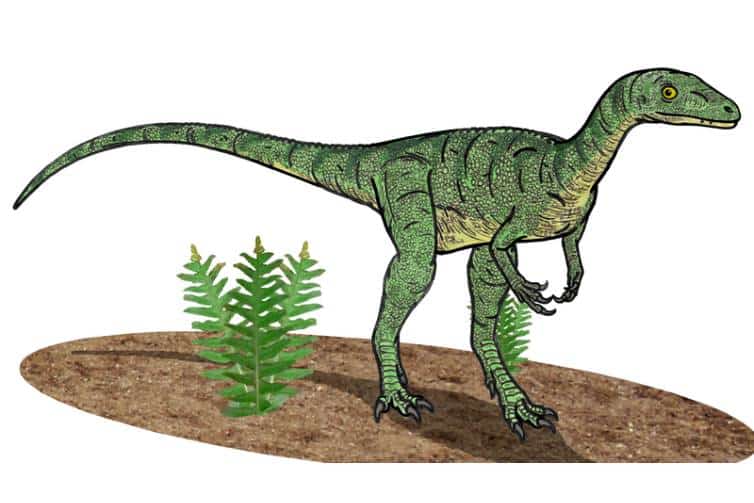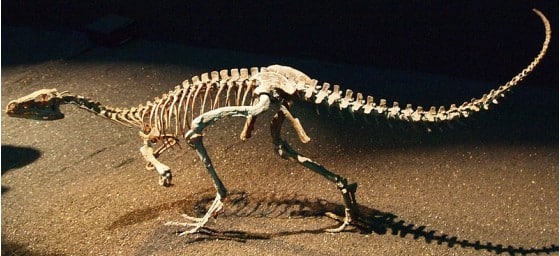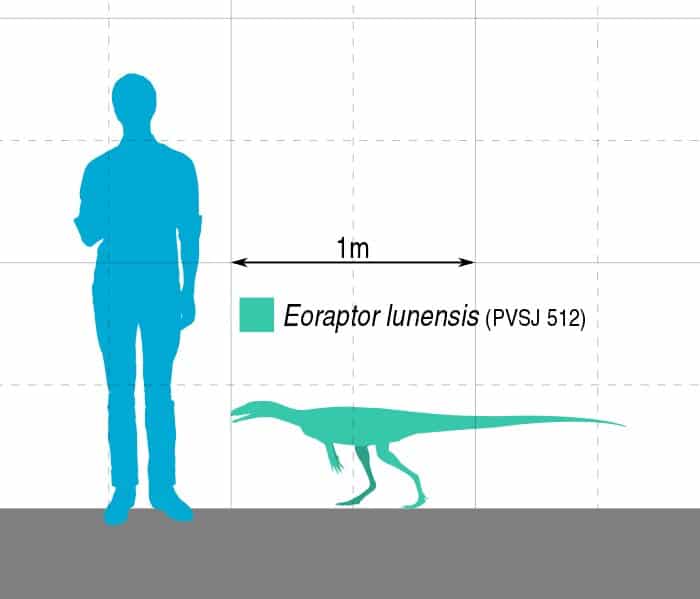In the vast tapestry of prehistoric life, few creatures can capture our imagination like the Eoraptor. This ancient dinosaur hails from the Triassic period and represents one of the earliest chapters in the evolutionary story of dinosaurs. Its name is derived from the Greek ‘eos’ meaning dawn and Latin ‘raptor’ meaning thief, which aptly describes this early predator of the dawn.
The Eoraptor’s existence was discovered in the late 20th century and has since provided invaluable insights into the early stages of dinosaur evolution. Its small size and primitive features are a testament to the humble beginnings of these magnificent creatures, which would later dominate the Earth for millions of years.
Key Facts
| Keyword | Fact |
|---|---|
| Eoraptor pronunciation | ee-oh-rap-tor |
| Meaning of name | Dawn thief |
| Group | Saurischia |
| Type Species | Eoraptor lunensis |
| Diet | Omnivore |
| When it Lived | 237.0 to 228.0 MYA |
| Period | Late Triassic |
| Epoch | Carnian |
| Length | 3.3 ft |
| Height | 1.3 ft |
| Weight | 0.22 tons |
| Mobility | Moved on two legs |
| First Discovery | 1991 by Ricardo Martinez |
| Location of first find | Ischigualasto Formation, Argentina |
| First Described by | 1993 by Paul Sereno |
| Holotype | PVSJ 512 |
Eoraptor Origins, Taxonomy and Timeline

The Eoraptor, or “Dawn thief”, is a name that reflects its status as one of the earliest known dinosaurs. The name is derived from the Greek ‘eos’ meaning dawn and Latin ‘raptor’ meaning thief. This signifies its early appearance in the dinosaur timeline and its predatory nature.
Taxonomically, this dinosaur belongs to the group Saurischia, which includes some of the most iconic dinosaurs like the Tyrannosaurus and the Brachiosaurus. However, Eoraptor’s exact family and placement within this group are still a subject of ongoing research. It has been suggested that it is a basal sauropodomorph that belongs close to the later division of theropods.
This dinosaur lived during the Triassic period. This was a time when the Earth was recovering from a mass extinction event and life was once again diversifying.
Listen to Pronunciation
Discovery & Fossil Evidence
The first fossil was discovered in 1991 by Ricardo Martinez in the Ischigualasto Formation in Argentina. This region is known for its rich fossil record, providing a window into the Triassic period. This discovery was significant as it represented one of the earliest known dinosaurs.

Since the initial discovery, several more fossils have been found, adding to our understanding of this early dinosaur. These fossils include partial skeletons and isolated bones that provide insights into its anatomy and lifestyle.
One notable specimen is the holotype, which includes a nearly complete skeleton. This specimen has been instrumental in understanding this dinosaur’s physical characteristics and its place in dinosaur evolution.
Eoraptor Size and Description
This was a relatively small dinosaur. Its size and physical characteristics provide a fascinating glimpse into the earliest stages of dinosaur evolution. Let’s take a closer look at this creature, which represents the beginning of dinosaurs as we know them.
Short description of Eoraptor
This was a small dinosaur, with a body shape that was agile and built for quick movement. Its head was proportionally large compared to its body with a set of sharp, backward-curving teeth that suggest a carnivorous diet. However, some paleontologists believe that Eoraptor may have been omnivorous, feeding on both small animals and plant matter. This is hinted at by the fact that it has different kinds of teeth that could be used for different dietary needs. Its long, flexible neck would have allowed it to reach for food in various directions.
It moved on two legs, a trait common among theropods. Its hind limbs were robust and muscular, while its forelimbs were much shorter. The tail was long and likely acted as a counterbalance while it moved. As for its skin, no direct evidence has been found but it is generally believed that like many other dinosaurs, Eoraptor may have had a covering of primitive feathers or scales.
Size and Weight of Type Species

This was not a large dinosaur by any means. In fact, it was quite small compared to many of its later relatives. It measured approximately 1 meter (3.3 feet) in length and is estimated to have weighed around 200 kilograms (0.22 tons). This size would have made it a nimble and agile predator, capable of quick movements to catch prey or evade larger predators.
However, it’s important to note that these are estimates based on the fossils that have been found so far. As with any extinct species, our understanding of its size and weight is subject to change as new discoveries are made and new research is conducted.
Despite its small size, this was a significant creature in the context of dinosaur evolution. Its existence marks one of the earliest chapters in the story of dinosaurs–a group of animals that would later come to dominate the Earth for millions of years.
The Dinosaur in Detail
The Eoraptor was a creature of remarkable adaptability. The possibility of an omnivorous diet, a trait not common among early dinosaurs, suggests a flexible approach to survival in the harsh Triassic environment. This adaptability likely played a crucial role in this dinosaur’s survival and its place in the dinosaur lineage.
One of the most fascinating aspects of this dinosaur is its teeth. Unlike later theropods, which typically had uniform, blade-like teeth, the Eoraptor had a variety of tooth shapes. This dental diversity is a strong indicator of an omnivorous diet, suggesting that the Eoraptor was capable of eating both meat and plant matter.
Its agility is another notable feature. Its bipedal locomotion and lightweight body would have made it a swift runner capable of quick bursts of speed when hunting or evading predators. This agility, combined with its dietary flexibility, paints a picture of a creature well-equipped for survival in the challenging Triassic landscape.
The Eoraptor in its Natural Habitat and Environment
This swift dinosaur lived in a world vastly different from the one we know today. It thrived during the Late Triassic period in a time when the Earth was still recovering from a mass extinction event. The climate was warm with no polar ice caps and the land was dominated by a single supercontinent known as Pangaea.
The environment in which this dinosaur lived was likely a mix of forests and open plains. The vegetation would have been dominated by ferns, cycads, and early conifers, providing a diverse diet for this omnivorous dinosaur. ITs agility and speed would have been advantageous in both hunting small prey and foraging for plant matter.
Being a small and agile creature, it likely had to contend with larger predators. Its speed and agility would have been crucial for evading these threats. On the other hand, as an omnivore, it would have had a diverse range of food sources–from small animals to plant matter. This dietary flexibility would have been a significant advantage in the changing Triassic landscape.
Interesting Points about Eoraptor
- This is one of the earliest known dinosaurs, giving it a significant place in the evolutionary history of dinosaurs.
- Its placement in the evolution of dinosaurs is still unclear and requires further investigation.
- The Eoraptor’s teeth were varied in shape, a trait that suggests a diverse diet and hints at an omnivorous nature.
- This was a small dinosaur that measured only about 1 meter in length, but its size likely contributed to its agility and speed.
- The discovery of this dinosaur in Argentina highlights the global distribution of dinosaurs, even in their early evolutionary stages.
Contemporary Dinosaurs
In the primordial world where the Eoraptor roamed, it was not alone. It shared its existence with a fascinating ensemble of Pangaean dinosaurs, each playing their own part in the intricate ballet of survival. Among these were the Herrerasaurus, Coloradisaurus, Riojasaurus, and Eodromaeus.
The Herrerasaurus was larger and more imposing and might have been a formidable presence for the smaller Eoraptor. Yet, the agile and swift Eoraptor could have navigated the landscape with a nimbleness that the Herrerasaurus lacked. This contrast in size and agility paints a picture of a dynamic ecosystem where each creature had its own strengths and strategies for survival.
The Coloradisaurus and Riojasaurus were both herbivores and likely had a different kind of interaction with the Eoraptor. While they were not direct competitors for food, their presence in the same environment suggests a complex web of interactions. The size difference between these gentle giants and the smaller Eoraptor show how diverse life could be.
The Eodromaeus, similar in size and lifestyle to the Eoraptor, presents an interesting comparison. These two dinosaurs might have had a relationship marked by rivalry. Yet, they also could have shared common threats and challenges, creating a sense of kinship in their shared struggle for survival. In this ancient world, the Eoraptor and its contemporaries danced a complex dance of survival and competition, each playing their part in the symphony of prehistoric life.
List Of All Dinosaurs
We have created a list of all dinosaurs we have covered here, sorted across the seven main groups of dinosaurs. We also include information about their type of diet, (omnivore, herbivore or carnivore) and the time they lived.
Frequently Asked Questions
It lived during the Late Triassic period in the Carnian epoch. This places its existence between 237.0 and 228.0 million years ago.
This dinosaur was likely an omnivore that could survive on both small animals and plant matter.
This was a small dinosaur, measuring approximately 1 meter (3.3 feet) in length and weighing around 200 kilograms (0.22 tons).
The first fossil was discovered in the Ischigualasto Formation in Argentina.
It was discovered by Ricardo Martinez in 1991.
The name means “Dawn thief”, derived from the Greek ‘eos’ meaning dawn and Latin ‘raptor’ meaning thief.
Sources
- https://www.nature.com/articles/361064a0
- https://www.researchgate.net/publication/257457973_Osteology_of_Eoraptor_lunensis_Dinosauria_Sauropodomorpha
- https://www.researchgate.net/publication/49753908_A_Basal_Dinosaur_from_the_Dawn_of_the_Dinosaur_Era_in_Southwestern_Pangaea
- https://www.researchgate.net/publication/272152780_A_late-surviving_basal_theropod_dinosaur_from_the_latest_Triassic_of_North_America
- https://www.researchgate.net/publication/40685650_A_Complete_Skeleton_of_a_Late_Triassic_Saurischian_and_the_Early_Evolution_of_Dinosaurs
Please note that the information in this article is based on various sources, drawing on scientific research, fossil evidence, and expert analysis. The aim is to provide a comprehensive and accurate overview of the Eoraptor, but please be aware that our understanding of dinosaurs and their world is constantly evolving as new discoveries are made.
This article was last fact-checked: Joey Arboleda, 06-11-2023
Featured Image Credit: Conty, CC BY 3.0, via Wikimedia Commons
